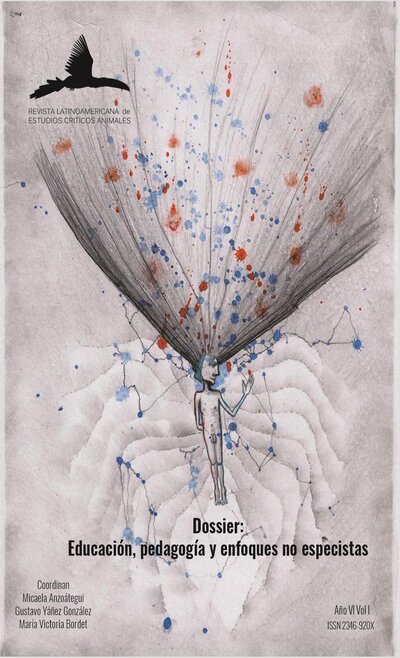Phagic necropolitics and life in the habeas viscus:
the slaughterhouse as an exceptional space and the agency of other animals in the unlivable places of existence
Keywords:
phagic necropolitics, habeas viscus, space of exception, agencyAbstract
The article intends to think about the theoretical scope on the animal issue from the social sciences. Through the concept of necropolitica and Habeas Viscus, we propose to analyze how the slaughterhouse becomes a place of everyday exceptionality where other animals become just flesh and the bases of a necropolithics are established, on which they are made murdered to sustain a culture erected on the phagic incorporation of the elimination of the other.
On the other hand, to understand how in the slaughterhouses forms of social existence are gestated in the process of transformation of the other animals in meat. We reflect on a reality of animal suffering through contemporary frames, on the fact that their lives do not deserve to be mourned anymore (Butler, 2010) and about the potentialities of animal agency (Hribal, 2014).
References
Agamben. G. (2003). Homo sacer I: El poder soberano y la nuda vida. Valencia, España: Pre-textos.
Agier, M. (2008). On the margins of the world: the refugee experience today. Malden, Estados Unidos: Polity.
Asamblea Antiespecista de Madrid (2014). En ese sitio maldito donde reina la tristeza... Reflexiones sobre las cárceles de animales humanos y no-humanos. Madrid, España: Ochodoscuatro Ediciones
Butler, J. (2010). Marcos de guerra. Las vidas lloradas. Barcelona, España: Paidós.
Chrulew, M. & Wadiwel, D.J. (2007). Edithors’ Introduction: Foucault and Animals. En Chrulew, M. & Wadiwel, D.J. (Eds.), Foucault and Animals (pp. 1-15). Boston, Estados Unidos: Brill.
Durkheim, E. (1987). La división del trabajo social. Madrid, España: Akal.
Feierstein, D. (2007). El genocidio como práctica social: entre el nazismo y la experiencia argentina. Hacia análisis del aniquilamiento como reorganizador de las relaciones sociales. Buenos Aires, Argentina: Fondo de Cultura Económica de Argentina.
Garmendia, A. (2018). Mataderos en México: investigación en el corazón de la industria cárnica. Recuperado de: http://traslosmuros.com/mataderos-rastros-mexico-investigacion.php
Gatti, G. (2008). El detenido-desaparecido. Narrativas posibles para una catástofre de la identidad. Montevideo, Uruguay: Trilce.
Harrison, R. (1964). Animal Machines. Londres, Inglaterra: Vincent Stuart Publishers Ltd.
Hribal, J. (2014). Los animales son parte de la clase trabajadora y otros ensayos. Madrid, España: Ochodoscuatro ediciones.
Latour, B. (2001). La esperanza de Pandora: ensayos sobre la realidad de los estudios de la ciencia. Barcelona, España: Gedisa Editorial.
Maddrell, A., y Sidaway, J. D. (2010). Introduction: bringing a spatial lens to death, dying, mourning and remembrance. En Maddrell, A., y J. D. Sidaway (Eds.), Deathscapes. Spaces for death, dying, mourning and remembering (pp. 1-16). Farnham, Inglaterra: Ashgate.
Mbembe, A. (2011). Necropolítica seguido de Sobre el gobierno privado indirecto. Barcelona, España: Melusina.
Pachirat, T. (2011). Every twelve seconds: industrialized slaughter and the politics of sight. New Haven and Londres, Inglaterra: Yale University Press.
Palmer, C. (2001). Taming the wild profusión of existing things? A study of Foucault, power, and human/animal relationships. Enviromental Ethics, Vol. 23, Winter 2001, 339-358.
Rancière. J. (2005). Sobre políticas estéticas. Barcelona, España: ContraTextos.
Serrano, R. (octubre de 2012). La sangre de las bestias. Orígenes del matadero industrial. Análisis del Matadero Público de Reses de Sevilla, obra del arquitecto José Sáez y López (1895-1915). Función y estilo. Simposio llevado a cabo en Jornadas Andaluzas de Patrimonio Industrial y de la Obra Pública.
Spillers, H. (1987). Mama’s baby, Papa’s maybe: An american gramar book in Culture and countermemory. The “American” Connection (Summer, 1987), Vol. 17, No.2, 64-87.
Thierman, S. (2010). Apparatuses of Animality: Foucault goes to a slaughterhouse. Foucault Studies, No. 9, 89-110.
Wadiwel, D.J. (2002). Cows and Sovereignty: Biopower and Animal Life. Borderlands e-journal, Vol. 1, No. 2. Recuperado de: http://www.borderlandsejournal.adelaide.edu.au/vol1no2_2002/wadiwel_cows.html
Weheliye, A. (2008). After man. American Literary History, Vol. 20, No. 1-2, Spring/Summer, 321-336.
Weheliye, A. (2014). Habeas viscus. Racializing assemblages, biopolitics and black feminist theories of the human. London, Inglaterra: Duke University press.
Wynter, S. (2003). Unsettling the Coloniality of Being/Power/Truth/Freedom: Towards the Man, After Man, Its Overrepresentation – An Argument. The New Centennial Review, Vol. 3, no. 3, Fall 2003, 257-337.
Downloads
Published
Issue
Section
License

This work is licensed under a Creative Commons Attribution-NonCommercial-ShareAlike 4.0 International License.
La Revista Latinoamericana de Estudios Críticos Animales con ISSN 2346-920X se adhiere a las diferentes iniciativas que promueven el acceso libre al conocimiento, por lo que todos los contenidos de la misma son de acceso libre y gratuito y publicados bajo la licencia Creative Commons, que permite su difusión pero impide la alteración de la obra e incluye siempre mención al autor/a y fuente.
Es decir, una licencia de tipo Atribución-NoComercial-SinObraDerivada.
Por ello, los correos electrónicos de los autores se encontrarán a disposición de los lectores, en caso de que deseen contactarlos personalmente.




